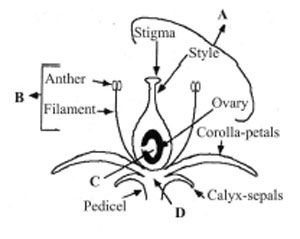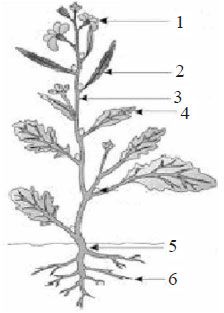Read the following statements and answer the questions.
- Gynoecium is situated in the centre and other parts of the flower are located on the rim of the thalamus almost at the same level.
- Ovary is half-inferior.
- Examples are plum, rose and peach.
Which condition of flowers is being described by the above statements ?
hypogyny
perigyny
epigyny
none of these
Correct Answer :
B. perigyny
According to the position of gynoecium, the flowers are of three kinds: perigynous, hypogynous and epigynous. The given statements describe the perigyny condition of flowers. In perigynous condition of flower, the calyx, corolla and androecium arises from the around of ovary. In these flowers the ovary is semi inferior. e.g, plum, rose and peach.
Related Questions
Match column-I with column-II and choose the correct option.
| A. Gram, sem, moong, | I. Medicine soyabean |
|---|---|
| B. Soyabean,groundnut | II. Ornamental |
| C. Indigofera | III. Fodder |
| D. Sunhemp | IV. Fibres |
| E. Sesbania, Trifolium | V. Dye |
| F. Lupin, sweet potato | VI. Edible oil |
| G. Mulethi | VII. Pulses |
A I, B II, C III, D IV, E V, F VI, G VII
A VII, B VI, C V, D IV, E III, F II, G I
A II, B IV, C VI, D I, E III, F V, G VII
A I, B III, C V, D VII, E II, F IV, G VI
Fibrous roots develop in maize from
upper nodes
lower nodes
upper internodes
none of these
Fibrous root system is better adopted than tap root system for
transport of organic matter.
absorption of water and minerals.
storage of food.
anchorage of plant to soil.
Which one of the following option shows the correct labelling of the structure marked as A, B, C & D?

A - Gynoecium, B - Megasporophyll, C - Ovule, D - Thalamus
A - Gynoecium, B - Stamen, C - Seed, D - Thalamus
A - Microsporophyll, B - Stamen, C - Ovule, D - Thalamus
A - Gynoecium, B - Stamen, C - Ovule, D - Thalamus
When a flower has both androecium and gynoecium, it is known as__________.
asexual
bisexual
unisexual
multisexual
The mature seeds of plants such as gram and peas, possess no endosperm, because
these plants are not angiosperms.
there is no double fertilization in them.
endosperm is not formed in them.
endosperm gets used up by the developing embryo during seed development.
The main purpose of phyllotaxy for the leaves is to provide sufficient_______.
soil
air
water
light
Pollen grains are produced within _________of stamen.
ovary
anther
filament
connective
In flower (X), the gynoecium occupies the highest position while the other parts are situated below it. The ovary in such flowers is said to be Y. Identify X and Y and select the correct option.
X - Epigynous, Y - Inferior
X - Perigynous, Y - Superior
X - Hypogynous, Y - Superior
X - Perigynous, Y - Half-inferior
Ginger is an underground stem. It is distinguished from root because
it lacks chlorophyll.
it stores food.
it has nodes and internodes.
it has xylem and vessels.
The primary roots and its branches constitute the
fibrous root system.
tap root system.
adventitious root system.
all of the above
The given figure shows a typical structure of monocotyledonous seeds. Identify A, B, C, D and E parts marked in the given figures.

A - Endosperm, B - Embryo, C - Scutellum, D - Coleorhiza, E - Coleoptile
A- Embryo, B - Endosperm, C - Scutellum, D - Coleoptile, E - Coleorhiza
A - Endosperm, B - Embryo, C - Scutellum, D - Coleoptile, E - Coleorhiza
A - Embryo, B - Endosperm, C - Scutellum, D - Coleorhiza, E - Coleoptile
Statement 1 : A simple leaf has undivided lamina.
Statement 2 : Leaves showing pinnate and palmate venations have various type of incisions.
Statement-1 and statement-2 are true and statement-2 is a correct explanation for statement -1.
Statement -1 and statement -2 are true but statement-2 is not a correct explanation for statement-1.
Statement-1 is true and statement-2 is false.
Both the statements are false.
The region of the root-tip which is involved in the formation of root hairs by epidermal cells is called the
region of maturation.
region of meristematic activity.
region of elongation.
none of the above.
The given figure shows the parts of flowering plant. Which parts of the given figure were involved in the following functions:
- Storing reserve food material
- Synthesis of plant growth regulators.
- Absorption of water and minerals from the soil.
- Providing a proper anchorage to the plant parts

5 and 6
1, 2 and 6
1, 2, 3 and 4
2, 4, 5 and 6
Which of the following statement(s) is/are correct about the fruit?
- Fruit is a mature or ripened ovary, developed before fertilization.
- It consists of a wall or pericarp and seeds.
- When pericarp is thick and fleshy, it is differentiated into outer mesocarp, middle epicarp and the inner endocarp.
- In mango and coconut, the fruit is known as a berry.
Only (i)
Both (ii) and (iii)
Only (ii)
All of these
Which is not a stem modification ?
Rhizome of ginger
Corm of Colocasia
Pitcher of Nepenthes
Tuber of potato
Pneumatophores are found in
the vegetation which is found in marshy and saline lake.
the vegetation which found in saline soil.
xerophytic condition.
hydrophytic condition.
Main function of leaf is
exchange of gases
increase the beauty of a tree
manufacturing of food
nerve impulse induction
Statement-1 : Ginger has a prostrate-growing rhizome.
Statement-2 : Shoot growth is not effected by gravity.
Statement-1 and statement-2 are true and Statement-2 is a correct explanation for statement-1.
Statement-1 and statement-2 are true but statement-2 is a correct explanation for statement-1.
Statement-1 is true and statement-2 is false.
Both the statements are false.
Seeds are regarded as products of sexual reproduction because they
can be stored for long time.
are result of fusion of pollen tube.
are result of fusion of gametes.
give rise to new plants.
Read the following statements and answer the question.
- It is the pattern of arrangement of leaves on the stem or branch.
- It is usually of three types - alternate, opposite and whorled.
- It is meant for getting maximum amount of light. statements?
Phyllotaxy
Venation
Inflorescencew
Aestivation
Prop roots of banyan tree are meant for
respiration.
absorption of water from soil.
providing support to big tree.
all of the above.
Cotyledons and testa respectively are edible parts in which of the following group?
walnut and tamarind
cashew nut and litchi
french bean and coconut
groundnut and pomegranate
The given figures (A & B) show two types of compound leaves. Choose the option which identity the correct compound leaf and their example (c).

A - Pinnately compound leaf, C - Neem
A - Palmately compound leaf, C - Neem
B- Pinnately compound leaf, C - Silk cotton
B- Palmately compound leaf, C - Silk cotton
The flower is the reproductive unit in the ___________ meant for ___________ reproduction.
angiosperms and sexual
gymnosperms and sexual
algae and asexual
pteridophytes and asexual
Match the column I with column II and choose the option which shows their correct match.
| Column I | Column II |
|---|---|
| A. Placentation | (i) Arrangement of flowers on the rachis |
| B. Aestivation | (ii) Modified shoot for sexual reproduction |
| C. Inflorescence | (iii) Arrangement of various whorls in the bud |
| D. Flower | (iv) Arrangement of ovules within an ovary |
A - (i), B - (ii), C - (iii), D - (iv)
A - (iii), B - (i), C - (ii), D - (iv)
A - (iii), B - (i), C - (iv), D - (ii)
A - (iv), B - (iii), C - (i), D - (ii)
Match the column-I containing types of aestivation with their examples given in column-II and choose the correct option.
| Column - I | Column-II |
|---|---|
| (Type of aestivation) | (Examples) |
| A. Valvate | I. Cotton |
| B. Twisted | II. Calotropis |
| C. Imbricate | III. Bean |
| D. Vexillary | IV. Gulmohar |
A I; B II; C IV; D III
A II; B I; C IV; D III
A II; B IV; C I; D III
A II; B I; C III; D IV
Which one of the following characteristics is not related to gynoecium?
It is the female reproductive part of the flower.
It is composed of stamens.
Stigma is usually at the tip of the style and is the receptive surface for pollen grains.
Each ovary bears one or more ovules attached to a flattened, cushion like placenta.
Which of the following plants is growing in swampy areas, where many roots come out of the ground and grow vertically upwards?
Potato
Opuntia
Rhizophora
Grass
